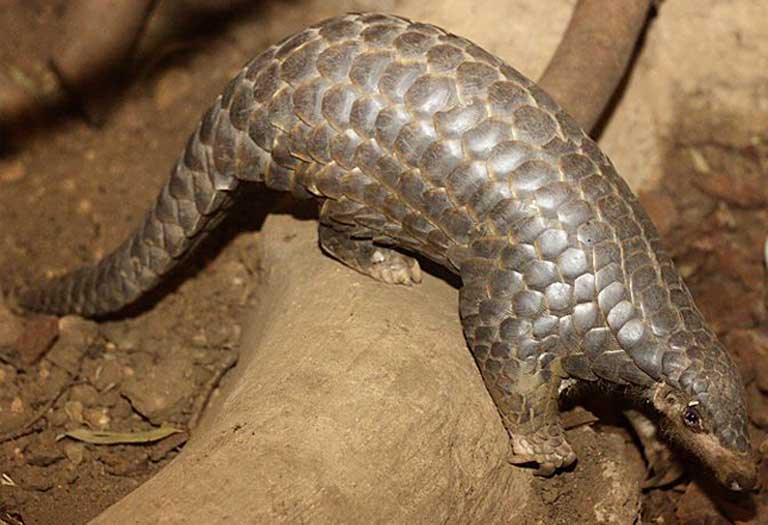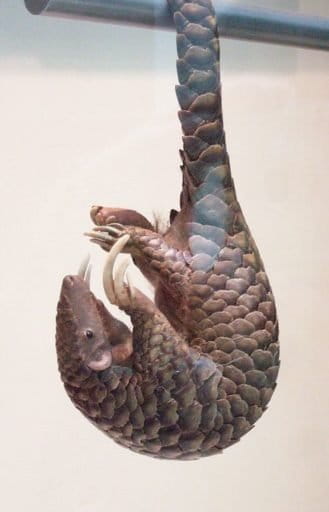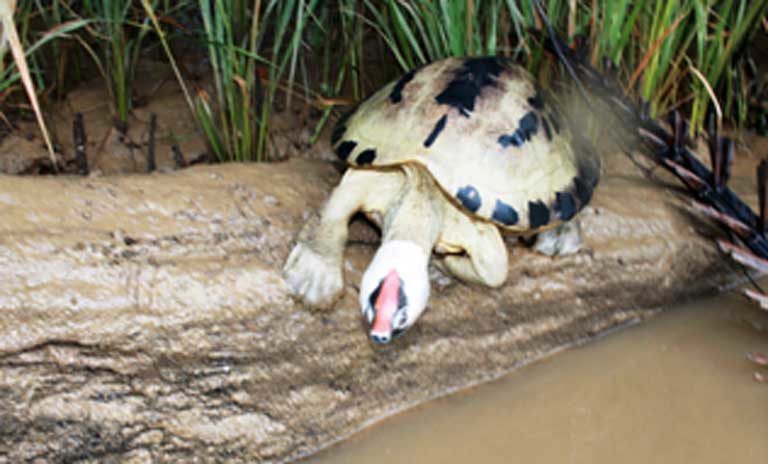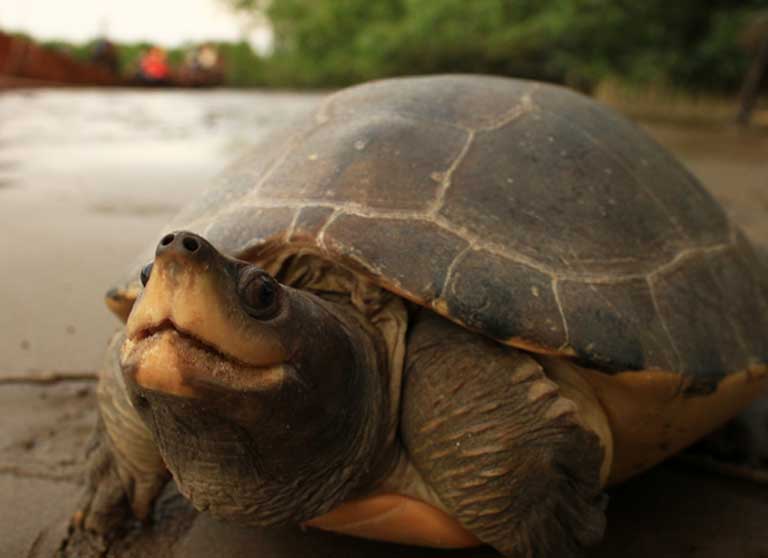- They are some of the world’s most unique, beautiful (though sometimes, really ugly), little known, but always seriously threatened species. They’re among the many Almost Famous Asian Animals conservationists are trying to save, and which Mongabay has featured in 2016.
- The examples included here are Asia’s urbane fishing cat, Vietnam’s heavily trafficked pangolin, Central Asia’s at risk wild yaks and saiga, and Indonesia’s Painted terrapin. All of these, and many more, could benefit from a holiday financial boost.
- Mostly these creatures need the same things: research and breeding facilities; educational workshops; and really cool, high tech, high ticket, radio collars and tracking devices. These items come with price tags ranging from a few hundred bucks, to thousands, to tens of thousands of dollars.

Among best selling items this gift-giving season are Hatchimals, a Retro Pop-Up Hot Dog Toaster, and a Monogrammed Blackhead Remover. But what do you buy for a harried, underfunded, hard to buy for, wildlife researcher who is desperately trying to conserve Asia’s most besieged and little known species?
Mongabay reached out to the scientists featured so far in this year’s Almost Famous Asian Animals article series, and asked what they needed. We offer here their heaetfelt holiday wish lists:
Fishing cat needs drop-off GPS collar…
“The fishing cat is the most charismatic focal species to be found [in the world’s] wetlands,” contends Sri Lankan researcher Anya Ratnayaka of the Urban Fishing Cat Project. “As a small cat, it’s one of the most poorly studied animals in the world.”
The Urban Fishing Cat Project urgently needs four GPS collars, equipped with drop-off mechanisms (USD $8,000); along with funding for two fishing cat educational awareness programs, including a projector, screen, handouts, venue costs, and audience snacks. (USD $1,800); plus annual pay for researchers and field assistants (a bargain at USD $7,000).

Why specifically drop-off GPS collars? Well, firstly, the collars allow researchers “to remotely track the movement and behavior of fishing cats in [the city environs of] Colombo’s urban wetland habitats,” says Ratnayaka. “We’re unable to use VHF collars… due to the fact that the VHF frequency is often disrupted due to high tension wire towers and home [TV] antennas.” GPS collars store multiple tracking locations over time and relay regular detailed data dumps. Researchers view the animals’ movements on Google Earth. The auto-drop-off feature allows scientists “to avoid having to put the fishing cat through the additional stress of being re-tranquilized and recaptured.”
The two education programs are critical because the diminutive fishing cat has been out-promoted and upstaged: “The Sri Lankan leopard, like all big cats, has taken the spotlight locally,” writes Ratnayaka. “So awareness programs are an important way of educating children and the general public on the fishing cat, as well as its two smaller cousins.… Unfortunately, only a handful of people know that these species exist, [though] each plays a vital role in its ecosystem and habitat niche.”
Asking Santa for “annual pay for researchers and field assistants” is a given for just about every conservation organization at the holidays. For fishing cat researchers, those wages would assure “the project is always well-staffed and able to meet the many challenges of working in a socio-political climate that is not the most conducive to urban wildlife conservation projects.”

Pangolin needs pangolin-proof tracking equipment
The research team at Save Vietnam’s Wildlife would like to “stress just how difficult it is to study Asian pangolins and how little is known about these animals in Vietnam. They’re nocturnal, they climb, they burrow, they roll into balls and all this makes traditional tracking [very] difficult.”
“After some tracking pilot projects where we learnt a lot about what does and doesn’t work, we are now trialing and testing transmitters that can withstand the pangolin’s activity, and also be attached to their scales,” writes Gillian Fuller of Save Vietnam’s Wildlife. “We need transmitters that last for at least five months for adequate data collection,” along with batteries big enough to endure, but not so heavy they act like a pangolin ball-and-chain. That used to be a tough order: “But a break through is at hand!”

The top wish list item: a new type of modular transmitter. “We are currently working with an electrical engineer who is designing a modular transmitter which will be able to use a regular mobile phone network or GPS, where each unit is small enough to allow for a low profile on the animal, and cause minimal disturbance to its natural behaviors (When fully developed, each transmitter will cost approximately USD $75 each).
“The beauty of the modular design is that we can attach different types of sensor to the transmitter, depending on what information we need, ie. light and temperature sensors,” says Fuller. “Getting these transmitters up to pilot stage for testing would be a huge boon for our research and also helpful to other species researchers.” (cost USD $5,000). The scientist counts this as “VITAL research, if we’re to understand and preserve this species.”
Another top pangolin need: a burrow cam. That’s “a cable camera we can embed within a wild pangolin burrow that would for the first time allow research data to be collected on Asian pangolin behavior during their restive hours.” (USD $500 per burrow cam).
Like everybody else, the pangolin people need money for salaries. In this case, they’re looking for a Vietnamese Field Officer “to monitor our tracking project and work with rangers and authorities” (USD $6,000 per year).
“Pangolins are a very precious species to Vietnam and the world; they are not only the only scaled mammal species [on the planet] but also of a totally unique order, Philodota,” says the researcher. “They act as a forest keystone species for the role they play in insect regulation. The effects of losing this species are not yet fully understood, which is why it is urgent that we conduct more research, not only to save individual animals, but to convince governments to protect pangolins from wildlife trafficking.”

Cold weather species in need of warm-hearted entrepreneurial attention
Researcher Joel Berger not only works with much neglected Asian animal species, but with very much neglected habitat. He’ll argue justifiably (to anyone who will listen) that while tropical and subtropical species — like rhinos and tigers — get the lion’s share of global attention and conservation funding; the hardy, hard-living animals that live in some of the world’s coldest mountain, or high desert habitat, barely get a metaphorical lump of coal this time of year. So much for Santa’s reindeer…
“The species that are losing here include Mongolia saiga, khulan, black-tailed gazelles, snow leopards, Argali, ibex, chiru, and wild yaks,” says Berger of the Wildlife Conservation Society. He sees saiga as a key species in the high, cold, dry mix: “Saiga once occupied the vast dry lands stretching from the Canadian Yukon to the British Isles, but are now restricted primarily to Kazakhstan and Mongolia — I’d love to use saiga as a vehicle to conserve more of their ilk,” he says.
“If we can find ways to balance livestock numbers, while maintaining livelihoods for herders, and a healthy environment for traders, with reduced numbers of goats, the land will support more food for native wildlife. Likewise, fewer livestock will reduce conflicts with species like snow leopards and wolves,” Berger says. “This has been a conundrum facing governance in western China, high elevation India, and Mongolia and yet serious workshops of the type proposed here have never occurred.”
The workshops Berger says these animals need deal with the harvesting and marketing of cashmere, the fine soft wool that keeps high altitude, cold country animals warm, which can also keep upscale and fashionable humans warm too.

“Cashmere and its trade have massive impacts on pastoralists in central Asia (positive ones), yet negative ones too on the remarkable animal biodiversity that lives in the shadows,” Berger explains. “Mongolia and China produce 90 percent of the world’s cashmere. I would like to sponsor two workshops that interface the pragmatic business community (e.g. fashion industry), with economists, social workers and conservationists in order to initiate serious conversations to determine how best to benefit all players — finding solutions for both animal and human. (Cost: USD $50,000, which sounds like a lot, until you realize you’re helping save a vast wintry habitat and many cool species).
Painted terrapin needs safe place to breed
You know a species is in trouble when a no-nonsense researcher starts typing in all caps: “WE SHOULD NOT LOSE THIS SPECIES,” writes Joko Guntoro, referring to the startlingly beautiful Painted terrapin, one of the world’s 25 most endangered turtles. Guntoro founded and leads Yayasan Satucita Lestari Indonesia, the Satucita foundation which focuses on saving Batagur borneoensis.
“This critically endangered species is beautiful, unique, suffers from a lack of attention, and has benefits for humans and ecosystems,” Guntoro extols. Saving it also means saving “mangrove forests, estuary and river ecosystem habitat,” where these animals “spend their daily lives.” Especially important is protecting nesting beaches where the terrapins are particularly vulnerable during nesting season.

But conserving the species is complicated: Indonesian fishermen are poor, and turtle eggs offer an easily gathered seasonal food. Mangrove habitat destruction and conversion into fish and shrimp aquaculture facilities and oil palm plantations is a rapidly escalating problem that threatens the terrapins.
“We know that it will take all the resources we can imagine to conserve Painted terrapins, but we get by with volunteers and small donations,” says Guntoro humbly. “We have a clear, long-term vision that conservation should not only focus on recovering the wild terrapin population, but should contribute to local welfare too, while restoring mangrove habitat. All of these goals are closely interconnected.”
Most urgently needed is a conservation and education center inside the terrapin’s habitat, where it can safely breed beyond the reach of poachers. “This would be an initial step to developing sustainable education-based tourism,” says Guntoro. (This is a big ticket item: USD $100,000 to $150,000).
Another critical need: radio or satellite telemetry equipment that could be attached to hatchlings and adults before release into the wild. This gadgetry would let researchers to know whether their “scientific methods are successful or not in increasing wild populations.” The equipment would help paint a detailed “picture for us about the Painted terrapin’s movement, range and habitat utilization.” (Cost: unspecified).

As with everywhere else in wildlife research, a great need persists for field staff funding. Guntoro’s group would like to “recruit villagers to support our field activities, such as conducting annual nest patrols to secure eggs from being poached.” (Cost: unspecified).
Guntoro isn’t greedy; any donation, of any amount, could offer “a great step toward realizing our dream of educating the community, protecting habitat, monitoring Painted terrapins and empowering villagers.”
Of course, the wish listings here only scratch the surface of Almost Famous Asian Animal research funding needs. To read more about the world’s fascinating, little known, but deserving, threatened animals — ranging from the Bumblebee bat to the Greater Adjutant stork, to the Mekong giant catfish, have a look here.
And have a happy holiday!



